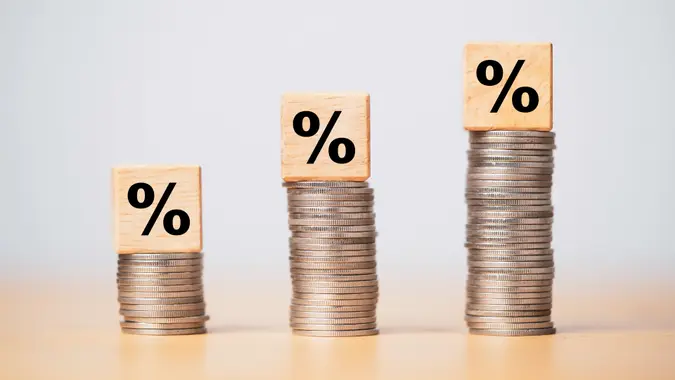Is $10,000 in Savings Good?

Commitment to Our Readers
GOBankingRates' editorial team is committed to bringing you unbiased reviews and information. We use data-driven methodologies to evaluate financial products and services - our reviews and ratings are not influenced by advertisers. You can read more about our editorial guidelines and our products and services review methodology.

20 Years
Helping You Live Richer

Reviewed
by Experts

Trusted by
Millions of Readers
The answer to the question, “Is $10,000 in savings good?” really depends on your circumstances. According to the Federal Reserve’s Survey of Consumer Finances, the median savings account balance for families was $8,000.
In that context, for most people, $10,000 in savings is considered a great accomplishment. This amount can be a huge milestone for someone. Or, it could be a starting point too.
Is $10,000 in Savings a Good Amount?
Whether $10,000 is a good savings amount likely depends on several key factors. Those factors may include age, cost-of-living and financial goals. While $10,000 in savings may feel adequate to a person who is younger, for those who are older, the amount may not feel like enough.
Also,$10,000 may not feel like enough if you’re living in an area with higher costs, such as New York or California.
Each individual or family has different financial goals. You could be saving for retirement, a down payment for a house or an emergency fund. Depending on your goal, the $10,000 benchmark may feel adequate or inadequate.
How To Tell if Your Savings Are on Track
Saving money is an important goal, but how do you know if your nest egg is enough? Look at these common benchmarks to help you see where you stand:
- What’s in your emergency fund? Typically saving three to six months of your living expenses is ideal. This amount could help with unexpected emergencies, medical bills or car issues.
- Have you saved 20%? Saving 20% of your income ensures that you have consistent savings for emergencies, retirement and long-term goals.
- What does your debt-to-savings ratio look like? Maintaining a good debt-to-savings ratio ensure your savings equals or outpaces your liabilities.
Is $10,000 Dollars a Lot of Money?
Try to have a grasp on how much you would realistically need in an emergency. While that may be difficult or even overwhelming to think about, it puts into context whether or not $10,000 is worth a lot.
For example, if you have are a homeowner and the water heater breaks, the cost to replace or fix could be higher in that emergency, in comparison to someone who might be renting and whose monthly rent pays toward these types of fixes.
Good To Know
The ideal emergency savings fund should cover three to six months worth of living expenses.
You also need to have a clear idea about your savings rate. According to the 2023 U.S. Census Bureau statistics, the median income for a household is $80,610. Having $10,000 savings represents a little over 12% of gross income.
The $10,000 savings milestone is a microgoal for a larger savings account. Having $10,000 in a savings account is a great start to building a larger savings account.
How Saving $10,000 Affects Y ou
Having $10,000 in savings represents a financial milestone, but can also be a win that impacts you mentally and emotionally. Here is the impact of having $10,000 in your savings account:
- Peace of mind: Knowing you have a financial cushion for unexpected expenses offers an added level of security.
- Confidence boost: Having $10,000 in savings signifies your ability to save and strive for a bigger financial goal.
- Increased motivation: After reaching the $10,000 milestone, individuals may want to strive for higher savings goals.
Savings Benchmarks by Age: Where Should You Be?
You may be wondering what the different savings benchmarks are by age. Check out this chart to learn more:
| AGe | Target Savings | Focus |
|---|---|---|
| 20s | 3 to 6 months of living expenses | -Build an emergency fund -Create a habit of saving |
| 30s | 1x your annual income | -Contribute to retirement accounts -Pay off high-interest debt |
| 40s | 3x your annual income | -Balance retirement savings with housing and family needs |
| 50s | 6x your annual income | -Max out retirement contributions -Substantially reduce debt |
| 60s | 8 to 10x your annual income | -Ensure financial security -Reflect on long term planning |
| 65+ | 10 to 12x your annual income | -Protect your savings -Withdrawal strategy for healthcare costs and living expenses |
What To Do With $10,000 Dollars
There are several options available if you have $10,000 and wisely use these funds. Some of those choices can include the following:
- Pay off debt. Use $10,000 to pay off high-interest debt or credit card balances.
- Open a high-yield savings account. Park your savings in a high-yield savings account to earn interest while keeping your money accessible.
- Explore investment options. Use the $10,000 to open retirement accounts like a 401(k) plan or IRA account.
- Add more to your emergency fund. Having an additional $10,000 can help build on your existing emergency fund.
What Can $10,000 Cover?
Having $10,000 accessible and available can help in real-word expenses. Having $10,000 can cover dental and medical emergencies. It can also help pay for mental health appointments or gym memberships.
You could use $10,000 to offer a small down payment on a car or home or you could you use the amount to pay off higher-interest credit card balance or other debt.
Having $10,000 means you can be better prepared for unexpected emergencies like a home or car repair. You could also add to an existing savings account or consider opening a $10,000 high-yield savings account.
Fund a luxury vacation for your family or multiple mid-range trips during the season.
Is Saving $10,000 a Year Good?
Saving $10,000 a year can be a significant achievement depending on your income, expenses and financial goals.
Evaluating annual savings in relation to income and goals means aiming to save at least 20% of your gross income every single year. Saving $10,000 a year also helps you remain consistent with financial milestones, like building your emergency fund, contributing regularly to your retirement accounts and saving for a down payment for a large purchase.
How Do You Set Realistic Targets for Consistent Savings?
Always make a budget. This allows you to Identify how much you can realistically save based on your income and expenses.
You may also want to attach your savings to a goal. For example, you have a goal of saving three to six months worth of living expenses for an emergency fund. Adding a bit more to that raises the stakes–a larger goal would be targeting saving for a down payment for a home.
As your income increases, plan to save more. One way to save more is to automate your savings. Make saving second nature by automating certain amounts to your savings account through direct deposit. In addition, you may want to be hyper-focused on paying off your debt.
How To Grow Your $10,000 Savings
Investing might be the way to grow your savings, if you’re up for it.
You may want to consider choosing to invest in high-growth assets like ETFs, stocks and index funds. These can help you make the most of your returns.
Use tax-advantaged accounts like IRAs, HSA plans and 401(k) plans to benefit from tax-deferred growth.
Finally, have a mindset that focuses on long-term growth. For example, reinvesting dividends or looking for high-interest or high-yield savings options so that you’re earning interest on money you already have.
What Are Budgeting Tips To Help Save More?
There are simple ways to add to your savings. Consider these strategies:
- Track your spending. Make an effort to find out where your income is going. Use a spreadsheet to keep track of costs and unnecessary expenses.
- Automate your savings. Try to create a way to make your savings automatic so that you don’t have to think about pulling money out every month and transferring it to your savings account.
- Open a high-yield savings account. If you have the minimum deposit, consider opening a high-yield savings account to maximize the returns on your existing funds.
- Adopt the 50/30/20 rule. Use 50% of your income for needs, 30% to wants and 20% for savings and debt repayment.
After You’ve Saved $10,000, What’s Next?
Once you achieve your goal of saving $10,000, then what? How do you move from saving to actively working toward wealth-building strategies?
You can try to expand your emergency fund to cover six to 12 months worth of living expenses, to give yourself a better cushion.
Focus on paying off high-interest debt to free up income and reduce financial strain.
You can also use that additional income to invest in your retirement plans or focus on strengthening your life and health insurance.
Is $10,000 Enough for You?
Whether $10,000 is enough depends on your unique financial situation and goals. For some, this amount may serve as a solid emergency fund, while for others, it’s a stepping stone toward larger milestones like homeownership or retirement. Consider your living expenses, financial obligations and future aspirations to determine if this amount provides for your needs.
Remember, personal finance is not one-size-fits-all–focus on building habits that help you save consistently and set realistic, personalized goals to achieve long-term financial security.
FAQ
Here are the answers to some of the most frequently asked questions about saving $10,000.- What are the best ways to save $10,000 quickly?
- To save $10,000 quickly, you will have to stick to a budget and cut out unnecessary expenses like eating out, subscriptions, and impulse purchases. You can also consider getting a side gig for additional income. In addition, automate your savings through your direct deposit and open a high-yield savings account.
- How does $10,000 in savings compare to the average person's savings?
- Having $10,000 in savings puts you ahead of many others. Recent surveys indicate the average median savings account balance is $8,000. You have set yourself up for an adequate financial cushion with $10,000.
- Should I invest my $10,000 or keep it in savings?
- Choosing to invest $10,000 or keep it in savings depends on when you'll need the money. If you need it sooner or want to keep that emergency fund on hand, keeping it in a high-yield savings account ensures you'll have quick access. On the other hand, if you're saving for a long-term goal--five years or more, for example--you might want to think about investing that money. Having a mix between saving and investing could be a smart and balanced strategy too.
- What are the risks of not having at least $10,000 in savings?
- Not having $10,000 in savings means you'll have to find other ways to grab the cash. You could turn to credit cards or loans for something unexpected, but be aware that those do come with high interest rates that you'll eventually have to pay back. If you're unemployed or otherwise in between jobs, it may be tempting to take a lesser-paying opportunity in the meantime that doesn't totally match up with your career plans or financial goals. All in all, not having a savings buffer can be stressful. Though, there are ways to cut down that stress if you're careful with your planning.
Our in-house research team and on-site financial experts work together to create content that’s accurate, impartial, and up to date. We fact-check every single statistic, quote and fact using trusted primary resources to make sure the information we provide is correct. You can learn more about GOBankingRates’ processes and standards in our editorial policy.
- U.S. Census Bureau. 2024. "Income in the United States: 2023."
 Written by
Written by  Edited by
Edited by 

























